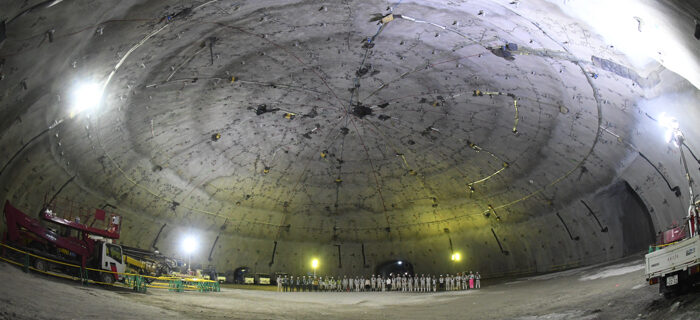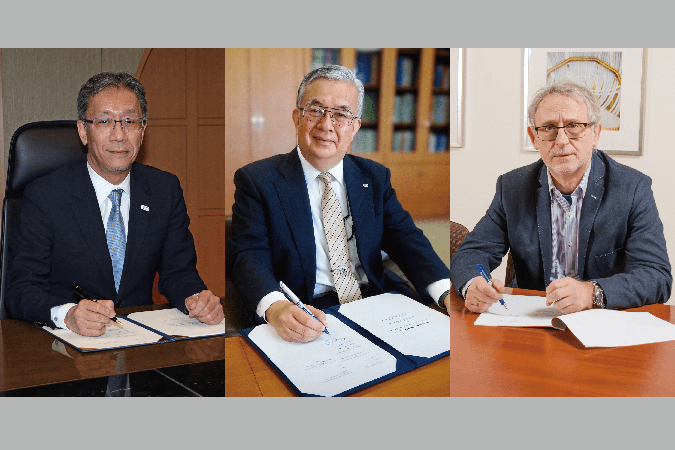

The second meeting of the Hyper-Kamiokande Experiment Financial Forum (HKFF) in which foreign agency representatives gathered to engage in discussions with host organizations and project members, was held at Faculty of Science Bldg. 4, Hongo Campus, The University of Tokyo on June 27th, 2019. Seed funding for Hyper-Kamiokande (HK) has already been allocated for the current Japanese fiscal year, and 12 countries, including Japan, expressed interest in the project.

Hyper-Kamiokande (HK), to be constructed in Kamioka, Hida City, Gifu Prefecture, is a new world-leading international scientific research project and aims to start its operation in the second half of the 2020s. The HK detector is planned to have eight times larger fiducial mass than its predecessor detector, Super-Kamiokande, and is equipped with newly developed high-sensitivity photosensors. The aim of HK is to elucidate the Grand Unified Theory and the history of the evolution of the universe through an investigation of proton decay and CP violation (the difference between neutrinos and antineutrinos), as well as the observation of neutrinos from supernova explosions.
Following the first meeting held on January 11th, 45 foreign agency representatives and scientists from 12 countries (Armenia, Brazil, Canada, France, Italy, South Korea, Poland, Russia, Spain, Switzerland, UK and Japan) gathered to hold discussions.
In the meeting, Prof. Takaaki Kajita, the director of both the Institute for Cosmic Ray Research (ICRR) and the Next-Generation Neutrino Science Organization (NNSO), made an opening address saying, “In order to realize HK and make it successful, solid international collaboration is essential. We’d like to ask each country to present their EOI (Expression of Interest) and hope we can discuss future strategies for realizing the HK project.” After that, Prof. Eligio Lisi of the National Institute for Nuclear Physics (INFN) – Bari gave a special lecture on the importance of neutrino research with the title of “Mapping the Neutrino World.”


Mr. Tomonori Nishii, director of the Scientific Research Institute Division in the Ministry of Education, Culture, Sports, Science and Technology (MEXT) said, “MEXT recognizes the importance of the scientific significance of the Hyper-Kamiokande Project, as well as the intensity of international competition with other countries. Based on the results of the ongoing feasibility study, MEXT intends to provide the necessary support from a strategic and long term perspective.” Also, the president of the University of Tokyo, Makoto Gonokami, commented, “Working together with MEXT, we are making every effort to secure sufficient funding.”

Prof. Naohito Saito of KEK (High Energy Accelerator Research Organization), the director of the J-PARC (Japan Proton Accelerator Research Complex) Center, and Prof. Kajita then presented their plans on future facilities and fundraising for the HK experiment.
Prof. Toshinori Mori from the International Center for Elementary Particle Physics (ICEPP), the University of Tokyo, who is the chair of the HK Advisory Committee (HKAC), presented outcomes of the Committee meeting held on June 25-26, 2019. Preliminary observations of the HKAC include the following points: (1)HK is a world-leading project with a compelling scientific case. (2)Great opportunity is available for international partners. (3)Substantial progress has been made in realizing HK. (4)Japan adequately takes responsibility for the infrastructure and facilities that will provide a solid foundation for the program. (5)International contributions are indispensable.
After the briefing on Japanese contributions to HK infrastructure, each representative from Brazil, Canada, France, Italy, South Korea, Poland, Russia, Spain, Sweden, Switzerland, and the UK make a presentation on their EOI. Proposed contributions include development and production of components of the HK detector such as high-performance photosensors and their covers, electronics, and data acquisition system, computing systems, calibration system, geomagnetism compensation coil, as well as upgrades and construction of a near detector system and beamline in the J-PARC site. HKFF discussed a summary of the second meeting before closing.

On June 28th, about 10 participants visited the J-PARC accelerator facility in Tokai Village, Ibaraki Prefecture, which will be used to produce the neutrino beam for the HK project. After the introduction given by Prof. Saito, the director of J-PARC Center, they toured the accelerators including the 30 GeV Main Ring (MR) which provides the high intensity proton beam for neutrino beam production, Neutrino Facility, Hadron Experimental Facility, and Materials and Life Science Experimental Facility (MLF), where they received explanations on the research goals and content from researchers of each facility.





